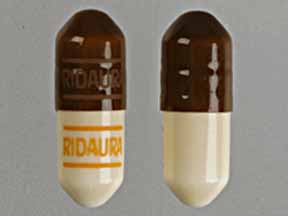Auranofin Side Effects
Applies to auranofin: oral capsule.
Warning
You should not use auranofin if you have ever had a severe reaction to gold therapy that affected your skin, lungs, bone marrow, blood cells, or your stomach or intestines.
Auranofin contains gold, which may be toxic and can cause symptoms such as rash, itching, mouth sores, or blood in your urine, or severe diarrhea.
Call your doctor at once if you have a severe skin rash or itching, mouth sores, severe diarrhea, pale skin, unusual tiredness, easy bruising or bleeding, blood in your urine or stools, or if you cough up blood.
Get emergency medical help if you have signs of an allergic reaction: hives; difficult breathing; swelling of your face, lips, tongue, or throat.
Call your doctor at once if you have:
-
pale skin, easy bruising, unusual bleeding (nosebleeds, bleeding gums), purple or red spots under your skin;
-
unusual tiredness, feeling short of breath;
-
severe skin rash or itching;
-
sudden chest pain, wheezing, dry cough, feeling short of breath;
-
severe or ongoing diarrhea, nausea, vomiting, or loss of appetite;
-
black, bloody, or tarry stools; or
-
kidney problems--puffy eyes, swelling in your ankles or feet, blood in your urine, urine that looks foamy.
Auranofin may cause more side effects on the stomach than gold injections cause. If you were switched from gold injections to auranofin capsules, tell your doctor if you have concerns about these side effects. You may need to use auranofin for a few months before your symptoms improve.
Common side effects may include:
-
diarrhea, loose stools;
-
rash, itching; or
-
blisters or ulcers in your mouth, red or swollen gums, trouble swallowing.
This is not a complete list of side effects and others may occur. Call your doctor for medical advice about side effects.
For Healthcare Professionals
Applies to auranofin: oral capsule.
Gastrointestinal
Very common (10% or more): Diarrhea/loose stools (47%), abdominal pain (14%),
stomatitis (may be manifested by shallow ulcers on the buccal membranes, on the borders of the tongue, and on the palate or in the pharynx) (13%), nausea/vomiting (10%)
Common (1% to 10%): %), Constipation, anorexia, flatulence, dyspepsia, dysgeusia, glossitis, gingivitis
Uncommon (0.1% to 1%): GI bleeding, melena, blood in stool, ulcerative enterocolitis
Rare (less than 0.1%): Dysphagia
Frequency not reported: Metallic taste, dry mucus membrane, inflammatory bowel disease[Ref]
Dermatologic
Very common (10% or more): Rash (24%), pruritus (17%), dermatitis
Common (1% to 10%): Alopecia, urticaria
Frequency not reported: Photosensitivity, exfoliative dermatitis, chrysiasis[Ref]
Ocular
Common (1% to 10%): Conjunctivitis
Rare (less than 0.1%): Gold deposits in the lens or cornea unassociated clinically with eye disorders or visual impairment
Frequency not reported: Corneal lesion[Ref]
Hematologic
Common (1% to 10%): Thrombocytopenia, anemia, leukopenia, eosinophilia
Uncommon (0.1% to 1%): Neutropenia
Rare (less than 0.1%): Aplastic anemia, agranulocytosis, pure red cell aplasia, pancytopenia[Ref]
Renal
Common (1% to 10%): Proteinuria, hematuria
Frequency not reported: Nephrotic syndrome[Ref]
Hepatic
Common (1% to 10%): Liver enzymes elevated
Rare (less than 0.1%): Jaundice[Ref]
Respiratory
Rare (0.01% to 0.1%): Bronchitis, interstitial pneumonitis, fibrosis
Frequency not reported: Progression of preexisting pulmonary disease[Ref]
Nervous system
Rare (less than 0.1%): Peripheral neuropathy
Frequency not reported: Headache, dizziness, Bell's palsy[Ref]
Other
Frequency not reported: Ototoxicity[Ref]
More about auranofin
- Check interactions
- Compare alternatives
- Reviews (2)
- Dosage information
- During pregnancy
- Drug class: antirheumatics
- Breastfeeding
- En español
Patient resources
Other brands
Professional resources
Other brands
Related treatment guides
References
1. Product Information. Ridaura (auranofin). SmithKline Beecham. 2001;PROD.
2. Cerner Multum, Inc. Australian Product Information.
Further information
Always consult your healthcare provider to ensure the information displayed on this page applies to your personal circumstances.
Some side effects may not be reported. You may report them to the FDA.

